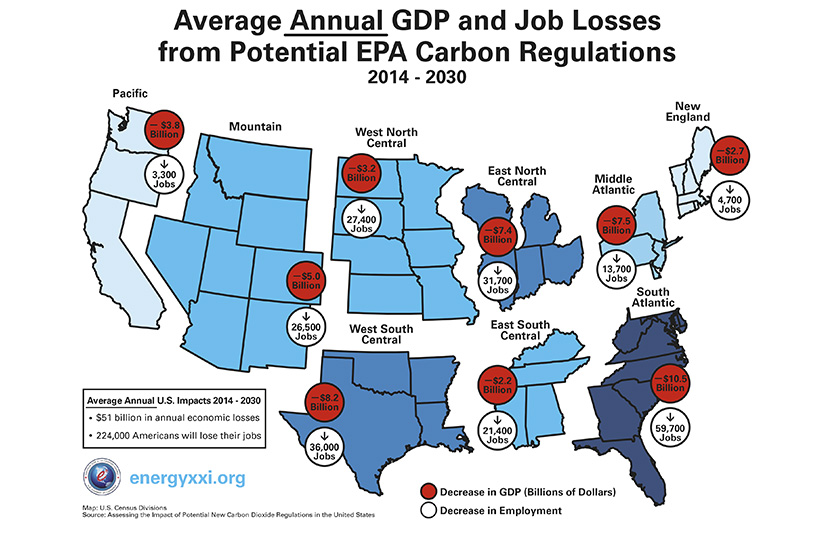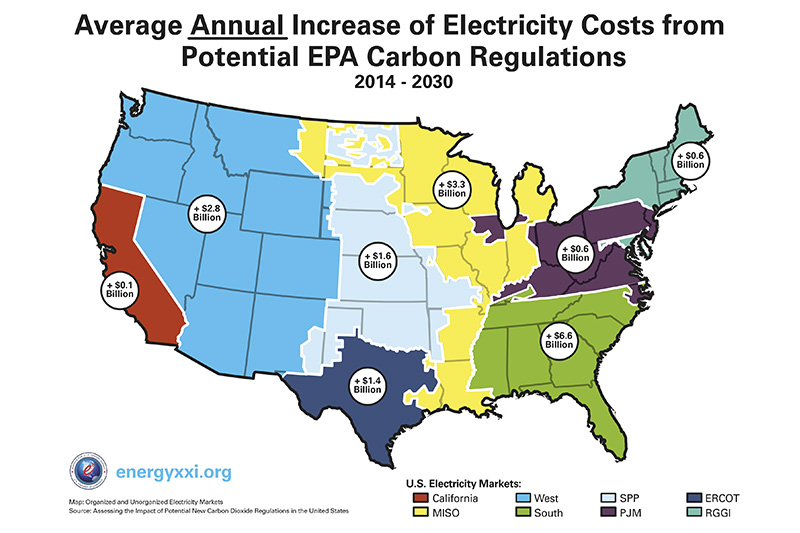Next week, it’s expected that President Obama will personally announce EPA’s latest effort to transform how America generates electricity. Remember in 2008, when Candidate Barack Obama said, electricity prices would “skyrocket?” This is what he meant, and it will affect every element of economic activity.
What is EPA about to do?
Next week, EPA will release carbon emission regulations for already-existing power plants. It’s a follow-up to last-year’s proposed regulations on new power plants.
How damaging could these regulations be on our economy?
The U.S. Chamber of Commerce’s Institute for 21st Century Energy released a report, “Assessing the Impact of Proposed New Carbon Regulations in the United States,” prepared with the assistance of the global energy and economics firm IHS. The analysis found that by 2030 potential new carbon regulations could:
- Cost as many as 442,000 jobs in 2022 and put 224,000 Americans out of work, on average, annually
- Cost $51 billion in GDP loss annually
- Lower disposable household income by 586 billion
- Increase electricity costs by more than $289 billion.
The report is based on an existing plan developed by the Natural Resources Defense Council (NRDC) and the Obama administration's previously-announced goal of reducing greenhouse gas emissions to 42% of 2005 levels by 2030. “We considered it as close as we could get to what the administration would be unveiling next week,” Karen Harbert, president and CEO of the Energy Institute said at a press conference.
Harbert added, “Americans deserve to have an accurate picture of the costs and benefits associated with the administration's plans to reduce carbon dioxide emissions through unprecedented and aggressive EPA regulations.”
When the costs for new incremental generating capacity, necessary infrastructure (transmission lines and natural gas and CO2 pipelines), decommissioning, stranded asset costs, and offsetting savings from lower fuel use and operation and maintenance are accounted for, total cumulative compliance costs will reach nearly $480 billion (in constant 2012 dollars) by 2030.
To put this into perspective, at an annual cost of $9.6 billion annually, the Mercury and Air Toxics Standard (MATS) is EPA’s most-expensive regulation on power generation. Potential EPA carbon regulations could be “nearly triple that amount, at $28.1 billion annually” from 2014-2030, the report finds.
How will this affect consumers?
Since the United States isn’t a homogenous mass, these potential rules will affect different areas of the country differently depending on what fuel sources they rely on and are able to tap for electricity generation. The report finds that the most damaging effects on jobs and the economy will be felt in much of the south and the Great Lakes region.

As for electricity prices, if you live in the South power region—much of the Southeast from Tennessee to Florida--expect to see the highest increases: $6.6 billion on average annually and $111.4 cumulatively from 2014-2030.

What about coal?
Coal-fired power plants will take more hits. Already, coal-fired power plants are under regulatory pressures. Potential carbon regulations will only add to their troubles. In February, the Energy Information Administration predicted thatnearly one-fifth of all coal-fired power plants would shut down by 2016 because of the Mercury and Air Toxics Standards (MATS) rule. The report estimates that an “additional 114 gigawatts—about 40% of existing capacity” will go offline by 2030 because of new carbon rules. As a percentage, electricity generated by coal will fall from 40% to 14%, while natural gas’ share of generation will rise from 27% to 46%.
Are the costs worth it?
Maybe you look at these numbers and say, “Well, that’s the price we’ll have to pay to reduce carbon emissions.” Let’s put it in the context of the global economy. The analysis estimates that potential carbon rules will reduce U.S. carbon dioxide emissions by 750 million metric tons in 2030. That’s only 1.8% of the global emissions predicted by the International Energy Agency. Using IEA's numbers, the report states, “the rest of the world will increase its power sector CO2 emissions by nearly 4,700 million metric tons (MMT), or 44%” from 2011-2030. So even aggressive U.S. emissions reductions will be overshadowed by the rest of the world, resulting in a true “All Pain, No Gain” scenario for the American economy.
"Is this the approach we want to take?" Harbert asked at the press conference.
That’s the question President Obama must answer and the debate the public needs to have.
What’s clear is these carbon rules are another example of Washington bureaucrats picking energy winners and losers. The biggest losers will be Americans who lose their jobs and feel the brunt of higher electricity costs.

No comments:
Post a Comment